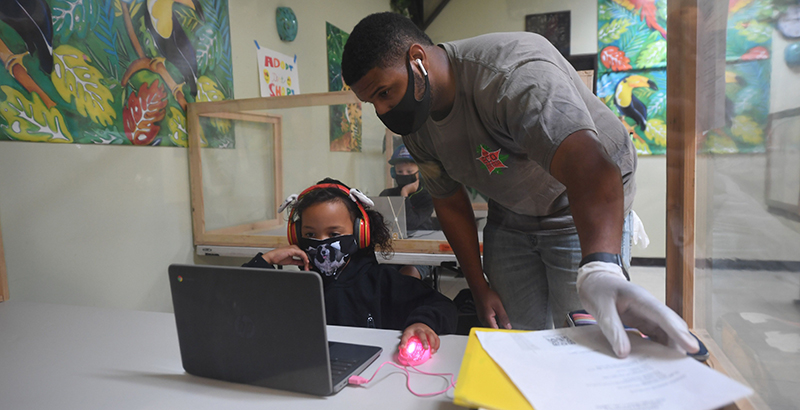Waldron: COVID Slide Is Not a Foregone Conclusion — 4 Ways a Small Group of Schools Is Defying Predictions for Low-Income Students of Color

When the COVID-19 pandemic caused nationwide school closings in March, it was widely predicted that virtual learning would lead to a loss of student learning, one that would be worst among students who are poor and have been impacted by structural racism.
As an educational technology provider for almost 10,000 schools, Curriculum Associates is in a unique position to track the pandemic’s effect on student achievement. Our team of researchers analyzed the online learning experiences of more than 8 million K-8 students from last spring, and the results confirm our worst fears: Children living in poverty or experiencing structural racism generally have suffered the most educationally during the pandemic.
But we also found some hope, places where students in challenging circumstances made meaningful progress during the switch to virtual learning.
By digging deeply into the spring data from our i-Ready system, which provided online lessons and assessments in the transition to remote learning for 25 percent of U.S. students, our team found a small group of schools that are bucking the trend predicted by the press and pundits of an unprecedented slide in learning, particularly for Black, Latino, Indigenous and low-income children.
These results show that the COVID slide is not preordained. In fact, many adults running schools found ways for their students to connect, think and learn during this national nightmare, no matter who they are or where they live.
In a brief developed by our research team, we document emerging evidence that sustaining students’ instructional time and performance levels is possible and is being done, often in spite of a history of disparity and inequity.
By analyzing the data from the i-Ready system, we identified 2,210 schools in low-income areas that serve students of color. Of those, 198 defied predictions. In this small but mighty cohort, we found that on average 88 percent of students were connected, and they completed an average of 34 lessons in about eight weeks of instruction. The average lesson passing rate was 81 percent. None of the schools had a passing rate lower than 70 percent.
Many of the success stories came from Miami-Dade and Duval County, Florida, where students were more likely to be connected, passing lessons and making real progress. Many students in these schools even saw growth at or near what they had achieved in 2018-19.
After conducting hours of interviews with educators from these schools to understand how they succeed, we discovered a consistent set of trends:
1 All technological barriers for students and families were eliminated.
Through deliberate planning and external partnerships, every child was given a device, ensured access to the internet through hotspots and information technology staff for support, and received Individualized Education Program accommodations.
2 A commitment to reaching every family personally was maintained throughout the spring.
Educators found ways to reach their students’ families in a variety of ways that were relevant to the families’ situations: hundreds of home visits, schools doors open for questions and visits, thousands of phone calls and texts, data chats via videoconferencing software, translation and pictorial resources, virtual proctoring and all staff having an “all hands” attitude.
3 Feedback loops of instruction, learning and assessment were integrated into everything the schools were already doing before COVID.
“Our students knew what to do — we just had to transfer that expectation to families,” said Dr. Earl Burth, principal of West Homestead K-8 Center, Miami-Dade Public Schools.
4 Educators followed up, held everyone accountable and celebrated progress on lessons.
When a teacher could not reach a family, assistant principals and principals were notified for follow-up. Administrators constantly looked at online instruction data and met frequently with teachers to discuss. Educators found creative ways to celebrate students, including public announcements, social media posts and certificates and awards mailed home.
These exemplary schools reveal that learning loss during the pandemic is not inevitable. With planning and hard work, adults can keep students who have been marginalized by systemic racism and economic disadvantages on track. School leaders across the country can learn from their success.
In fact, a subset of schools, where students completed diagnostic testing that produced detailed data in addition to data from their online lessons, made learning gains across the 2019-20 school year that exceeded their gains in reading for the previous year and were nearly the same in mathematics. Together, the successes across the nearly 200 schools prove that children living in poverty and impacted by systemic racism can achieve with the right resources, persistent educators and a challenging curriculum.
Unfortunately, they are the exception. In far too many places, students don’t have access to devices, and schools haven’t been able to adapt to online instruction. For millions of children, the pandemic has compounded educational inequities they’ve suffered their whole lives.
Stories like these can help shift the pervasive deficit mindset about education in communities of color or poverty, which undermines any belief that great things are possible and reinforces an unacceptable status quo that renders improvement and change less likely.
As the new school year begins with large numbers of students learning virtually, educators face the challenge of ensuring that all students can connect, engage and continue to learn. It is difficult, but it is not insurmountable. It is time to prove the prognosticators wrong and show that all students can succeed — and even thrive — during this national crisis.
Rob Waldron is the CEO of Curriculum Associates based in North Billerica, Massachusetts.
Get stories like these delivered straight to your inbox. Sign up for The 74 Newsletter

;)